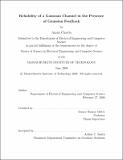Reliability of a Gaussian channel in the presence of Gaussian feedback
Author(s)
Chawla, Aman
DownloadFull printable version (198.8Kb)
Other Contributors
Massachusetts Institute of Technology. Dept. of Electrical Engineering and Computer Science.
Advisor
Sanjoy Kumar Mitter.
Terms of use
Metadata
Show full item recordAbstract
The communication reliability, or error exponent, of a continuous time, infinite band-width, Additive White Gaussian Noise channel was studied under a peak power constraint, in the presence of a feedback channel that was also a continuous time peak-power constrained infinite bandwidth Additive White Gaussian Noise channel. Motivated by [9], a two phase scheme was studied, where, in the first phase, the Encoder transmits the message in small bit-packets and the Decoder then informs the Encoder of the decoded message. With this knowledge, in the second phase, the Encoder sends a confirm or deny signal to the Decoder and the Decoder then informs the Encoder of its final action. In the first phase, the Encoder uses an orthogonal signalling scheme and the Decoder uses a deterministic Identification code. In the second phase, the Encoder uses antipodal signalling, while the Decoder utilizes a sequential semi-orthogonal peak-power constrained anytime code. To improve the reliability of the anytime code, additional messages are pipelined into the forward channel by the Encoder once it finishes its phase two transmission, before receiving the Decoder's phase two transmission. (cont.) Using this scheme, the following lower bound on the reliability of this channel is obtained: where 4R is the average rate of data transmission and C are the capacities of where R is the average rate of data transmission and Ci and 02 are the capacities of the forward and reverse channels respectively. To achieve this reliability, the capacity of the reverse channel, C2 must be greater than the forward capacity C1.
Description
Thesis (S.M.)--Massachusetts Institute of Technology, Dept. of Electrical Engineering and Computer Science, 2006. This electronic version was submitted by the student author. The certified thesis is available in the Institute Archives and Special Collections. Includes bibliographical references (leaves 29-30).
Date issued
2006Department
Massachusetts Institute of Technology. Department of Electrical Engineering and Computer SciencePublisher
Massachusetts Institute of Technology
Keywords
Electrical Engineering and Computer Science.